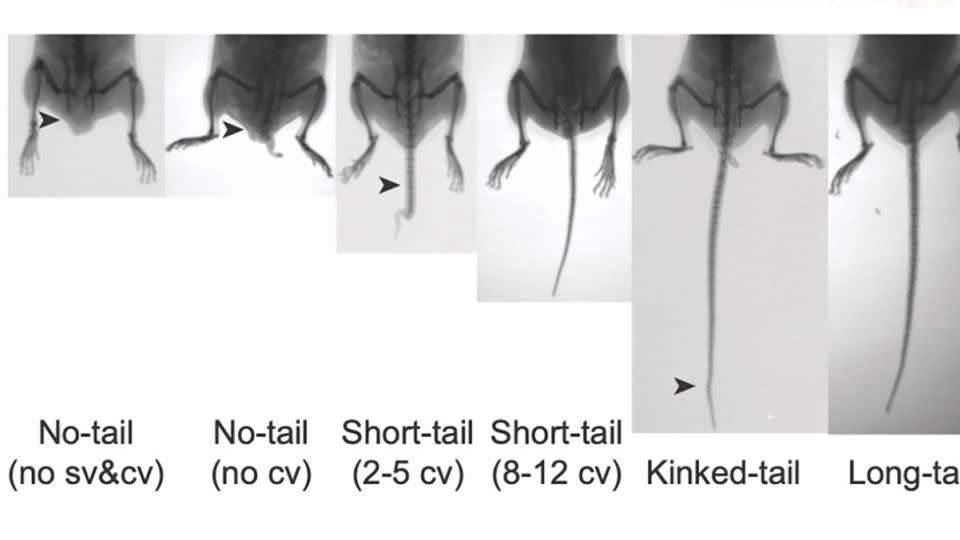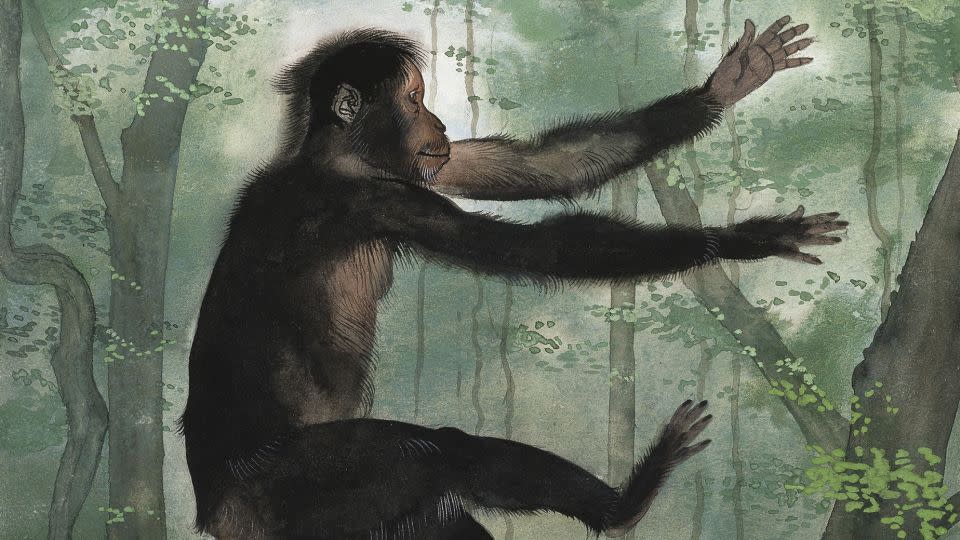Sign up for CNN’s Wonder Theory science newsletter. Explore the universe with news about fascinating discoveries, scientific developments and more.
Humans have many wonderful features, but we lack something common to most animals with backbones: a tail. Exactly why that is has been a mystery.
Tails are useful for balance, propulsion, communication and defense against biting insects. Humans and our closest primate relatives – the great apes – said goodbye to tails about 25 million years ago, when the group split from the Old World monkeys. The loss has long been associated with our transition to bipedalism, but little was known about the genetic factors that caused primate taillessness.
Now scientists have traced our tail loss to a short sequence of genetic code that is abundant in our genome but was dismissed for decades as junk DNA, a sequence that seemingly serves no biological purpose. They identified the fragment, known as an Alu element, in the regulatory code of a gene associated with tail length, called TBXT. Alu is also part of a class known as jumping genes. These are genetic sequences that are able to change their location in the genome and induce or reverse mutations.
At some point in our distant past, the Alu element AluY jumped into the TBXT gene in the ancestor of great apes (great apes and humans). When scientists compared the DNA of six hominin species and 15 non-hominoid primates, they found AluY only in hominin genomes, the scientists reported Feb. 28 in the journal Nature. And in experiments with genetically modified mice – a process that took about four years – tinkering with Alu insertions in rodents’ TBXT genes resulted in variable tail lengths.
Before this study, “there were many hypotheses about why hominoids evolved to be tailless,” the most common of which linked tailless to upright posture and the evolution of bipedal walking, said lead study author Bo Xia, a researcher at the Gene Regulation Observatory . and principal investigator at the Broad Institute of MIT and Harvard University.
But in terms of identifying exactly how humans and great apes lost their tails, “nothing had been discovered or hypothesized (previously),” Xia told CNN in an email. “Our discovery is the first time we have proposed a genetic mechanism,” he said.
And because tails are an extension of the spinal column, the study’s findings may also have implications for understanding neural tube malformations that can occur during human fetal development.
‘One in a million’
A breakthrough moment for the researchers came when York University. York University Grossman School of Medicine.

“It must have been something that thousands of other geneticists looked at,” Yanai told CNN. “That’s incredible, right? That everyone is looking at the same thing, and Bo noticed something that they all didn’t notice.”
Alu elements are abundant in human DNA; the insertion in TBXT is “literally one in a million that we have in our genome,” Yanai said. But while most researchers had dismissed TBXT’s Alu insertion as junk DNA, Xia noticed its proximity to a neighboring Alu element. He suspected that if they mated, it could trigger a process that would disrupt protein production in the TBXT gene.
“That happened in a flash. And then it took four years of working with mice to actually test it,” Yanai said.
In their experiments, the researchers used CRISPR gene editing technology to breed mice with the Alu insertion in their TBXT genes. They discovered that Alu made the TBXT gene produce two types of proteins. One of these led to shorter tails; the more of that protein the genes produced, the shorter the tails.
This discovery adds to a growing body of evidence that Alu elements and other jumping gene families may not be “junk” after all, Yanai said.
“While we understand how they replicate in the genome, we are now forced to think about how they also shape very important aspects of physiology, of morphology and of development,” he said. “I find it amazing that one Alu element – one little thing – can lead to the loss of an entire appendage like the tail.”
The efficiency and simplicity of Alu mechanisms for influencing gene function have been underappreciated for far too long, Xia added.
“The more I study the genome, the more I realize how little we know about it,” says Xia.
Waistless and tree-dwelling
Humans still have tails when we develop as embryos in the womb; this small appendage is a descendant of the caudal ancestor of all vertebrates and comprises 10 to 12 vertebrae. It is only visible from the fifth to sixth week of pregnancy, and by the eighth week of fetus the tail has usually disappeared. Some babies retain an embryonic remnant of a tail, but this is extremely rare and such tails typically lack bone and cartilage and are not part of the spinal cord, another team of researchers reported in 2012.
But while the new study explains the “how” of tail loss in humans and great apes, the “why” is still an open question, says biological anthropologist Liza Shapiro, professor of anthropology at the University of Texas. Austin.
“I think it is very interesting to pinpoint a genetic mechanism that may have been responsible for the loss of the tail in hominins, and this paper makes a valuable contribution in that way,” said Shapiro, who was not at the investigation was involved, in an email to CNN. .


“However, if this was a mutation that randomly led to tail loss in our monkey ancestors, it still begs the question of whether or not the mutation was maintained because it was functionally beneficial (an evolutionary adaptation), or simply was not a hindrance . says Shapiro, who studies how primates move and the role of the spine in primate locomotion.
By the time ancient primates started walking on two legs, they had already lost their tails. The oldest members of the hominid lineage are the early apes Proconsul and Ekembo (found in Kenya and dated to 21 million years ago and 18 million years ago, respectively). Fossils show that these ancient primates, although tailless, were tree-dwellers that walked on four limbs with a horizontal body posture, much like monkeys, Shapiro said.
“So the tail was lost first, and then the locomotion we associate with living apes evolved,” Shapiro said. “But it doesn’t help us understand why the tail was lost in the first place.”
The idea that upright walking and tail loss were functionally linked, with the tail muscles being repurposed as pelvic floor muscles, “is an old idea that is NOT consistent with the fossil record,” she added.
“Evolution works from what is already there, so I wouldn’t say the loss of the tail helps us understand the evolution of human bipedalism in a direct way. However, it does help us understand our ape ancestry,” she said.
A tail as old as time
For modern humans, tails are a distant genetic memory. But the story of our tails is far from over, and there is still much to be researched about tail loss, Xia said.
Future research could investigate other consequences of the Alu element in TBXT, such as its impact on the development and behavior of human embryos, he suggested. Although the absence of a tail is the most visible result of the Alu insertion, it is possible that the gene’s presence also triggered other developmental shifts – as well as changes in locomotion and related behavior in early hominins – to accommodate tail loss.
Additional genes likely also played a role in tail loss. Although Alu’s role “appears to be very important, other genetic factors likely contributed to the permanent disappearance of the tails of our primate ancestors,” Xia said.
“It’s reasonable to think that there were many more mutations associated with stabilizing tail loss at that time,” Yanai said. And because such evolutionary changes are complex, our tails are gone for good, he added. Even if the driving mutation identified in the study could be reversed, “it still wouldn’t bring back the tail.”
The new findings may also shed light on a type of neural tube defect in embryos known as spina bifida. In their experiments, the researchers found that when mice were genetically engineered for tail loss, some developed neural tube malformations that resembled spina bifida in humans.
“Maybe the reason we have this condition in humans is the trade-off our ancestors made 25 million years ago to lose their tails,” Yanai said. “Now that we have made this link to this specific genetic element and this particularly important gene, it could open doors to studying neurological defects.”
Mindy Weisberger is a science writer and media producer whose work has appeared in the magazines LiveScience, Scientific American, and How It Works.
For more CNN news and newsletters, create an account at CNN.com